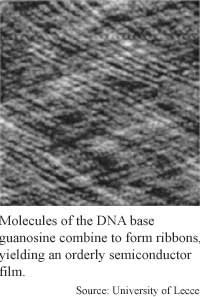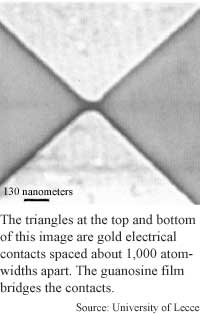
DNA
device detects light signals
By
Eric Smalley,
Technology Research NewsDNA is famous for its ability to assemble itself into very long strings of code made up of four bases. With a nod to nature's choice of materials, a team of researchers in Italy is tapping the self-assembly talent of one of the bases to form a thin film that produces an electric current when light shines on it.
The researchers have built a device that uses a film of guanosine in place of the inorganic silicon or gallium arsenide semiconductor material usually used in photodiodes. Photodiodes are the light-sensing elements of photodetectors, which are used to convert light pulse signals to electrical signals in communications networks.
The guanosine films are cheaper and have a better light sensitivity than the inorganic semiconductor used in commercial photodiodes, said Ross Rinaldi, a physics professor at the University of Lecce in Italy.
The researchers produced the film by depositing a tiny drop of water containing about 100,000 guanosine molecules between a pair of very closely spaced gold electrodes. As the water evaporated, the guanosine molecules assembled themselves into ribbons that interconnected to form a film with semiconductor properties. The film formed a contact between the electrodes in the researchers' prototype photodiode.
The researchers chose guanosine because it has good self-assembly properties and is oxidized the least of the four DNA bases, "insuring good conductivity properties in the ordered film," said Rinaldi. Oxidation results when oxygen in air combines with material on a surface. Oxidation turns semiconductors into insulators, which block electron flow.
The devices use relatively short 100-nanometer long spans of the film. As a result, the gold electrodes have to be produced using electron beam lithography rather than the simpler, less expensive photolithography process of commercial chipmaking, said Rinaldi.
The researchers are working on avoiding this by making longer films. "We are working to extend the ordering lengths of the biomolecular layer towards the 250 nanometer range, thus reducing the spatial resolution required for the contacts fabrication," she said.
This would make it possible to mass-produce the guanosine photodiodes using standard photolithography to make the electrodes and modified inkjet printer nozzles to make the guanosine films, said Rinaldi.
Rinaldi's research colleagues were Emanuela Branca and Roberto Cingolani of the University of Lecce, and Salvatore Masiero, Gian Piero Spada and Giovanni Gottarelli of the University of Bologna. They published the research in the May 28, 2001 issue of the journal Applied Physics Letters. The research was funded by the Italian National Institute for Condensed Matter Physics.
Timeline: 5 years
Funding: Government
TRN Categories: Materials Science and Engineering; Biological, Chemical, DNA and Molecular Computing
Story Type: News
Related Elements: Technical paper, "Photodetectors fabricated from a self-assembly of a deoxyguanosine derivative," Applied Physics Letters, May 28, 2001
es using standard photolithography to make the electrodes and modified inkjet printer nozzles to make the guanosine films, said Rinaldi.\par
\par Rinaldi's research colleagues were Emanuela Branca and Roberto Cingolani of the University of Lecce, and Salvatore Masiero, Gian Piero Spada and Giovanni Gottarelli of the University of Bologna. They published the research in the May 28, 2001 issue of the journal Applied Physics Letters. The research was funded by the Italian National Institute for Condensed Matter Physics. \par
\par Timeline: 5 years
\par Funding: Government
\par TRN Categories: Materials Science and Engineering; Biological, Chemical, DNA and Molecular Computing
\par Story Type: News
\par Related Elements: Technical paper, "Photodetectors fabricated from a self-assembly of a deoxyguanosine derivative," Applied Physics Letters, May 28, 2001
Advertisements:
June 13/20, 2001
Page One
Stressed silicon goes faster
Artificial synapses copy brain dynamics
DNA device detects light signals
Lightwaves channel atoms to make chips
Process promises better LCD production


News:
Research News Roundup
Research Watch blog
Features:
View from the High Ground Q&A
How It Works
RSS Feeds:
News
Ad links:
Buy an ad link
| Advertisements:
|
 |
Ad links: Clear History
Buy an ad link
|
TRN
Newswire and Headline Feeds for Web sites
|
© Copyright Technology Research News, LLC 2000-2006. All rights reserved.